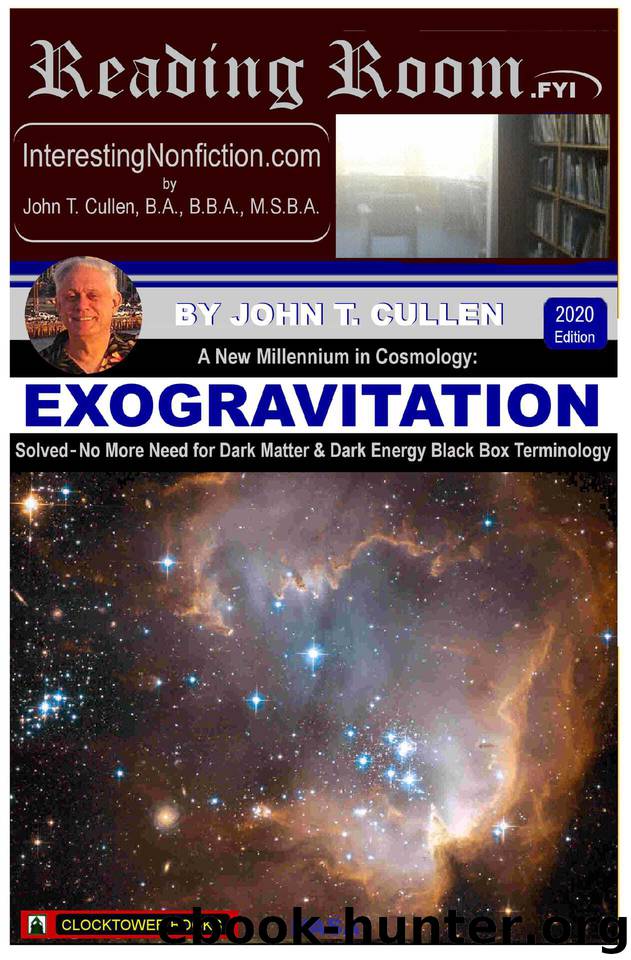Exogravitation: A New MIllennium in Cosmology: Solved: No More Need For Dark Matter & Dark Energy Black Box Terminology by Cullen John T

Author:Cullen, John T. [Cullen, John T.]
Language: eng
Format: epub
Publisher: Clocktower Books, San Diego
Published: 2020-04-09T16:00:00+00:00
From Newton's Philosophiae Naturalis Principia Mathematica (Mathematical Principles of Natural Philosophy, 1687) there developed a classic problem of celestial mechanics called the three-body problem. At its core was a study of the complex interaction among three gravitational masses: earth, its moon, and the sun. The realization was now in place, that the heliocentric solar system (still thought to be the center of the universe) worked as one huge engine. All the parts in fact shared a common gravitation. If you are the moon, and you are flying around the earth, you are also influenced by the gravitation of the sun, and in fact of Venus, and Mars, and every other body.
In the Principia , there was laid out what would become known as Newton's Universal Law of Gravitation: that the force of gravity on an object is the inverse of the square of its distance from the source of the attraction. The apple has very little mass, and therefore little gravity that it can exert on the earth. When it hangs in the tree, that force is a potential energy. When it starts moving, potential energy converts to kinetic (moving) energy. The earth has a great mass, which it exerts on the apple, which goes smack as it is stopped by the lawn, and the miles of soil and rock and molten iron underneath, from going right to the center of the earth. Earth's gravitational force keeps the moon in orbit, although the moon, at a large fraction of the aggregate gravitation of the two, contributes a lot of force in itself, far more than the apple. As the moon orbits earth, it is also pulled toward the sun in an oscillating manner, and this directly affects the ocean tides on earth. So if you understood more precisely the mathematics of this, you could predict the tides! And that would be highly useful to a growing major maritime power such as Great Britain.
This brings us back to the three-body problem. The concept of the three objects moving together is, in a broad manner, easy to understand. The oscillation occurs because the pull of earth on moon is partially neutralized when the moon is between the sun and the earth, which are both tugging at the moon. When the moon is on the other side of the earth, then the gravitation of sun and moon combine to create a greater pull (with the moon's own attraction to the earth). The pull of these forces on the oceans, therefore, creates predictable variations in tidal fluctuations. Predictable, that is, if you can work out the precise mathematics, and that's what mathematicians and astronomers did over the next several centuries. The three-body problem is a special instance, or subset, of the n-body problem, which ultimately describes how the entire universe hangs together. And if that weren't enough, by the time we draw close to the Twentieth Century, there start to be some distant rumblings about the behavior of light, which leads us in the
Download
This site does not store any files on its server. We only index and link to content provided by other sites. Please contact the content providers to delete copyright contents if any and email us, we'll remove relevant links or contents immediately.
Tools of Titans by Timothy Ferriss(7813)
Turbulence by E. J. Noyes(7700)
Astrophysics for People in a Hurry by Neil DeGrasse Tyson(5001)
Secrets of Antigravity Propulsion: Tesla, UFOs, and Classified Aerospace Technology by Ph.D. Paul A. Laviolette(4992)
Design of Trajectory Optimization Approach for Space Maneuver Vehicle Skip Entry Problems by Runqi Chai & Al Savvaris & Antonios Tsourdos & Senchun Chai(4840)
Room 212 by Kate Stewart(4736)
Pale Blue Dot by Carl Sagan(4614)
The David Icke Guide to the Global Conspiracy (and how to end it) by David Icke(4380)
A Journey Through Divination and Astronomy by Publishing Pottermore(4250)
Apollo 8 by Jeffrey Kluger(3512)
Goodbye Paradise(3446)
Losing the Nobel Prize by Brian Keating(3425)
COSMOS by Carl Sagan(3347)
The Five People You Meet in Heaven by Mitch Albom(3334)
How to Read Water: Clues and Patterns from Puddles to the Sea (Natural Navigation) by Tristan Gooley(3240)
Brief Answers to the Big Questions by Stephen Hawking(3239)
How to Read Nature by Tristan Gooley(3078)
The Order of Time by Carlo Rovelli(3073)
A Brief History of Time by Stephen Hawking(2819)
